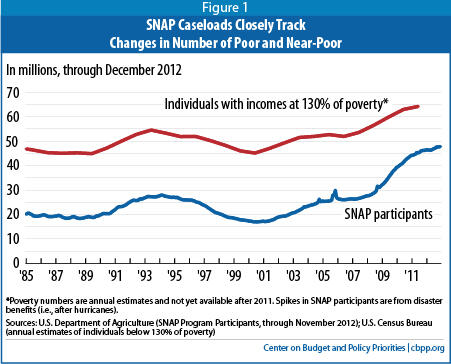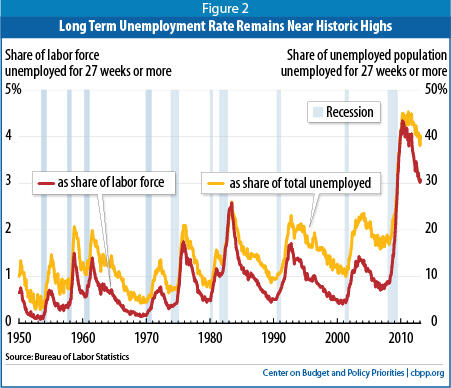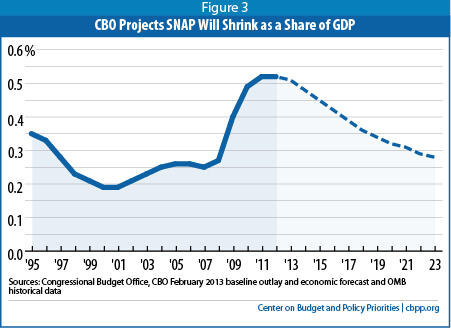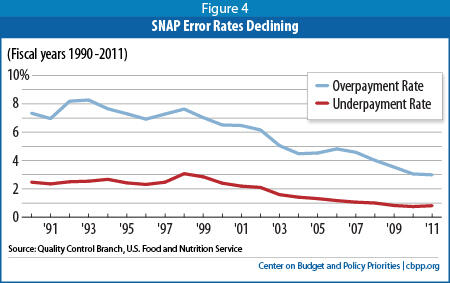- Home
- SNAP Is Effective And Efficient
SNAP Is Effective and Efficient
The Supplemental Nutrition Assistance Program (SNAP — formerly the Food Stamp Program) is the cornerstone of the nation’s safety net and nutrition assistance programs. It currently provides over 47 million participants in about 23 million low-income households with debit cards they can use to purchase food each month. Because eligibility generally is not restricted to specific subgroups of people, SNAP serves a wide range of low-income households, including families with children, elderly people, and people with disabilities. Participants include families with adults who work in low-wage jobs, unemployed workers, and people with fixed incomes, such as Social Security. About 72 percent of SNAP recipients live in households with children; more than one-quarter live in households with seniors or people with disabilities.
In recent years SNAP has achieved impressive results in meeting the needs of low-income Americans while maintaining strong program integrity and payment accuracy.
- SNAP has responded effectively to the recession. SNAP caseloads increased significantly between late 2007 and 2011, as the recession and lagging recovery battered the economic circumstances of millions of Americans and dramatically increased the number of low-income households who qualified and applied for help from the program. SNAP enrollment growth slowed in 2012, however, as the economy began to recover. In addition, the 2009 Recovery Act increased SNAP benefits as a way of delivering economic stimulus. Policymakers deemed SNAP to be effective for this purpose because of its broad reach among low-income populations and its high efficiency.
- The recent growth in SNAP spending is temporary. The Congressional Budget Office (CBO) predicts that SNAP spending will fall as a share of Gross Domestic Product (GDP) in coming years as the economy recovers and the Recovery Act provisions end. SNAP is expected to return to 1995 levels as a share of GDP by 2019. Over the long term, SNAP is not growing faster than the overall economy and thus is not contributing to the nation’s long-term fiscal problems.
- SNAP reaches a high share of people who are eligible. SNAP reached 75 percent of all eligible individuals in a typical month in 2010 (the most recent year available). This is a significant improvement from 2002, when the participation rate bottomed out at 54 percent. The participation rate among eligible low-income working families rose from 43 percent in 2002 to about 65 percent in 2010.
- SNAP payment accuracy is at all-time highs. SNAP has one of the most rigorous quality control systems of any public benefit program, and despite the recent growth in caseloads, the share of total SNAP payments that represent overpayments, underpayments, or payments to ineligible households reached a record low in fiscal year 2011.
SNAP Has Responded Quickly and Effectively to Recession
After unemployment insurance, SNAP historically has been the most responsive federal program in assisting families and communities during economic downturns. The recent downturn was no exception: national SNAP enrollment is at an all-time high, though in the last six months enrollment growth has slowed substantially. (See Figure 1.)

The number of people receiving SNAP increased in every state as a result of the recession. Some of the states that were hit hardest by the recession saw the largest caseload increases. For example Nevada, Florida, Idaho, and Utah, the four states with the greatest growth in the number of unemployed workers between 2007 and 2011, also had the greatest growth in the number of SNAP recipients.
SNAP Caseloads Grew Primarily Because of the Recession
The recent caseload growth resulted primarily from more households qualifying because of the recession and more eligible households applying for help. The Congressional Budget Office (CBO) has confirmed that “the primary reason for the increase in the number of participants was the deep recession...and subsequent slow recovery; there were no significant legislative expansions of eligibility.”[1]
SNAP caseloads can grow for two reasons: because more households are qualifying for the program and enrolling and because a larger share of eligible households are signing up. Both of these occurred in recent years.
- The number of people eligible for SNAP increased because of the recession and lagging recovery. The number of people with income below 130 percent of poverty (the SNAP income limit) increased substantially, from 54 million in 2007, before the recession, to 60 million in 2009 and 64 million in 2011, allowing more households to qualify for help from the program.
- Participation among eligible households also increased.The U.S. Department of Agriculture (USDA) estimates that the SNAP participation rate rose from 65 percent in 2007 to 75 percent in 2010, the most recent year available. Households that already were poor became poorer during the recession. The widespread and prolonged effects of the recession may have made it more difficult for other family members and communities to provide support to people who are struggling to make ends meet. In addition, states continued efforts begun before the recession to reach more eligible households, particularly working families and senior citizens, by simplifying SNAP policies and procedures. All of these factors likely contributed to rising participation rates.
Long-term Unemployment Has Played an Important Role

- Workers who are unemployed for a long period are more likely to deplete their assets, exhaust unemployment insurance, and turn to SNAP for help, as it is one of the only safety net programs available for many long-term unemployed workers. Other safety net programs, such as cash assistance under the Temporary Assistance for Needy Families (TANF) and state General Assistance programs have, in most states, not been responsive to rising need during the recession and its aftermath.[2]
- The Joint Economic Committee recently reported that more than one in five workers who had been unemployed for over six months received SNAP in 2010.
In 2012, as overall and long-term unemployment began to fall, SNAP caseload growth slowed substantially, and by early 2013 SNAP caseloads were declining in some states. As CBO has noted, this pattern of SNAP caseload declines lagging behind falling unemployment rates follows the pattern of previous recessions:
Even as the unemployment rate began to decline from its 1992, 2003, and 2010 peaks, decreases in participation typically lagged improvement in the economy by several years. For example, the number of SNAP participants rose steadily from about 20 million in the fall of 1989 to more than 27 million in April 1994 — nearly two years after the unemployment rate began to fall and a full three years after the official end of the recession in March 1991. The number of people receiving SNAP benefits began to climb again in 2001 and continued to grow until 2006, more than two years after the unemployment rate began to decline and well after that recession ended (in November 2001).[3]
The Recovery Act’s Increase in SNAP Benefits Has Boosted the Economy and Eased Hardship
SNAP has not only expanded dramatically to meet rising need during and after the recession, but has also delivered about $35 billion (between April 2009 and September 2012) in additional SNAP benefits under the Recovery Act. The Recovery Act provided a temporary, 13.6 percent boost in the maximum SNAP benefit beginning in federal fiscal year 2009. Congress enacted this provision as a fast and effective economic stimulus measure to help push against the rising tide of hardship for low-income Americans. The increase is phasing down and is scheduled to end entirely on October 31, 2013.
Economists consider SNAP one of the most effective forms of economic stimulus. Moody’s Analytics estimates that in a weak economy, every dollar increase in SNAP benefits generates about $1.70 in economic activity. Similarly, CBO rated an increase in SNAP benefits as one of the two most cost-effective of all spending and tax options it examined for boosting growth and jobs in a weak economy.
A USDA study of the impacts of the increase in SNAP benefits from the Recovery Act found that the prevalence of very low food security of households with incomes eligible for SNAP (130 percent of poverty and less) decreased from 2008 to 2009 (before and after the SNAP benefit increase, respectively). The percent of households with very low food security was expected to increase due to changes in income and employment resulting from the recession, yet it decreased; this decline was not shown among higher-income households.
SNAP Is Not Contributing to the Nation’s Long-term Fiscal Problems
While SNAP spending has risen considerably since the recession hit, the increases are expected to be temporary. CBO predicts that SNAP enrollment will fall in coming years as the economy recovers. CBO projects that the number of people receiving SNAP in a typical month will begin to fall in 2014 (from 47.7 million in fiscal year 2013 to 47.6 million in 2014, 46.5 million in 2015, and 34.3 million by 2023.)[5] By 2019, SNAP spending will return to 1995 recession levels as a share of GDP. (See Figure 3.)

Once the economy has fully recovered, SNAP costs are expected to rise only in response to growth in the size of the low-income population and increases in food prices. Unlike health care programs and Social Security, there are no demographic or programmatic pressures that will cause SNAP costs to grow faster than the overall economy. Thus, SNAP is not contributing to the nation’s long-term fiscal problems.
SNAP Eligibility Changes Have Not Played a Large Role in SNAP Growth
Some policymakers have claimed that changes in SNAP that have made more people eligible, particularly in higher-income households, have played a large role in SNAP growth. While it is true that two SNAP eligibility changes in recent years have contributed to SNAP caseload growth, the effects of these changes have been dwarfed by the other factors cited above.
-
A state option known as broad-based categorical eligibility allows states to extend SNAP eligibility to certain low-income households whose gross income is above 130 percent of poverty, (but generally with disposable income is below the poverty line), or who have modest assets. More than 40 states have adopted the option, including about 30 states that have adopted it since 2007. The state option makes SNAP available primarily to low-income working families with children or seniors, but the option does not result in substantial SNAP benefits going to non-needy families. In 2011 only 2 percent of SNAP households had monthly disposable income (i.e., income after SNAP’s deductions for expenses such as child care and high housing costs) above the poverty line.[6]
According to CBO’s estimates of proposals to repeal the state option, states’ use of the option accounts for about 2 percent of SNAP program costs. In a report investigating the option in 2012, the Government Accountability Office (GAO) concluded, “Other studies, our own analysis of USDA data, and information we obtained during our site visits indicate the impact of [broad-based categorical eligibility] on SNAP participation is likely small.”[7]
- In addition, some unemployed childless adults — who typically face a three-month time limit on SNAP benefits — became eligible during and after the recession under longstanding authority for states to waive the time limit during periods of high unemployment. (In addition, the Recovery Act suspended the time limit temporarily in 2009 and 2010.)[8] This temporary change likely increased SNAP participation by some 1 to 2 million people in a typical month over the last several years. As the economy improves, states will no longer qualify for statewide waivers and will be required to reinstate the three-month limit in many or all areas.[9]
SNAP Payment Error Rates at All-Time Lows
SNAP has one of the most rigorous payment error measurement systems of any public benefit program. Each year states pull a representative sample (totaling about 50,000 cases nationally) and thoroughly review the accuracy of their eligibility and benefit decisions. Federal officials re-review a subsample of the cases to ensure accuracy in the error rates. States are subject to fiscal penalties if their error rates are persistently higher than the national average.
Despite the recent rapid caseload growth, USDA reports that states achieved a record-low SNAP error rate in fiscal year 2011. (See Figure 4.) Only 3 percent of all SNAP benefits represented overpayments, meaning they either went to ineligible households or went to eligible households but in excessive amounts, and more than 98 percent of SNAP benefits were issued to eligible households.

In addition, the combined error rate — that is, the sum of overpayments and underpayments (see box, “Combined Error Rate Does Not Represent Excessive Federal Spending or Fraud, p. 9) reached an all-time low in 2011 of just 3.8 percent. Prior to enactment of major reforms in the 2002 Farm Bill, states with combined error rates below 6 percent qualified for a bonus payment or enhanced funding in recognition of their exemplary performance; for eight years running the national error rate has exceeded this standard.
In comparison, the Internal Revenue Service estimates a tax noncompliance rate of 16.9 percent in 2006 (the most recently studied year). This represents a $450 billion loss to the federal government in one year. Underreporting of business income alone cost the federal government $122 billion in 2006, and small businesses report less than half of their income.[10]
Efforts to Curb Other SNAP Abuses Are Extensive and Effective
USDA has cut “trafficking” — the sale of SNAP benefits for cash, which violates federal law — by three-quarters over the past 15 years. Only 1 percent, or $1 in every $100 of SNAP benefits, is trafficked. USDA has also permanently disqualified thousands of retail stores from the program for not following federal requirements. In fiscal year 2012, USDA’s retailer fraud investigations resulted in 342 convictions and $57.7 million in recoveries. When cases of SNAP fraud are reported in the news, it is because the offenders have been caught, evidence that states and USDA are aggressively combating fraud.
In addition, SNAP now comes in the form of an electronic debit card –– like the ATM cards that most Americans carry in their wallets — which recipients can use in the supermarket checkout line only to purchase food. This has been a key tool to reduce trafficking. Sophisticated computer programs monitor SNAP transactions for patterns that may suggest abuse. Federal and state law enforcement agencies are then alerted and investigate. Retailers or SNAP recipients who defraud SNAP by trading their benefit cards for money or misrepresenting their circumstances face tough criminal penalties.
Combined Error Rate Does Not Represent Excessive Federal Spending or Fraud
Some critics have attempted to portray SNAP’s combined error rate as a measure of excessive federal SNAP expenditures due to errors. This is incorrect: the combined error rate includes both overpayments, which cost the federal government money, and underpayments,which “represent unintentional financial savings to the federal government,” as the Government Accountability Office has noted.
-
The overpayment error rate counts benefits issued to ineligible households or issued to eligible households in excess of what federal rules provide. The underpayment error rate measures errors in which eligible, participating households received smaller benefits than SNAP rules direct. The combined payment error rate is the sum, not the net, of the overpayment and underpayment error rates.
In 2011, for example, the overpayment error rate was 2.99 percent and the underpayment rate was 0.81 percent. The combined error rate was thus 3.80 percent. But the net loss to the federal governmentfrom errors was only 2.18 percent.
- It is important to note that overpayments count toward a state’s error rate even when the state recoups the overpaid benefits from households. In fiscal year 2011, the most recent year for which data are available, states collected about $314 million in overissued benefits.
- Relatively few SNAP errors represent dishonesty or fraud by recipients. The overwhelming majority result from honest mistakes by recipients, eligibility workers, data entry clerks, or computer programmers. In recent years, states have reported that about 60 percent of the dollar value of overpayments and almost 90 percent of the dollar value of underpayments were their fault, rather than recipients’ fault. Much of the rest of overpayments resulted from innocent errors by households facing a program with complex rules.
- States and USDA also measure error rates for cases in which states denied or terminated benefits. (The underpayment error rate includes only cases where states gave some benefits, but not as much as the household should have received under program rules. It does not include actions that completely denied SNAP to eligible low-income households.) Nationally, in 8 percent of the instances in which households were denied or terminated from SNAP, the action was found to be in error. Since USDA does not calculate the amount of benefits that these improperly denied households would have received, this “negative error rate” is not directly comparable to the overpayment and underpayment error rates. Nonetheless, improper denials and terminations, like underpayments, result in significant (if unintended) savings to the program. In fact, the combined savings from underpayments and improper denials may actually exceed the loss resulting from overpayments of benefits.
Further Improvements Underway
SNAP has succeeded in providing timely food assistance to eligible low-income households while maintaining strong program integrity and payment accuracy.
There nonetheless is room for improvement, both in reaching eligible households and in combating illegal activities on the part of retailers and households. States and USDA are working together to develop policies and procedures that will strengthen program integrity without making it more difficult for eligible households to participate. In recent months USDA has announced new anti-fraud initiatives and the farm bills under consideration in the House and Senate include numerous provisions designed to enhance SNAP program integrity.
In addition, states have launched their own initiatives. For example, Utah has developed a tool that helps eligibility workers conduct data matches across a wide range of state and federal databases (such as Motor Vehicles, State Vital Statistics, Social Security Administration, Child Support, Unemployment Insurance, state tax records, consumer credit checks, and other commercial databases). These databases help states verify the income (and other eligibility factors) that the household reports and detect instances where households may not have reported accurately. Prior to the change, eligibility workers needed to query each database separately, which could involve separate links, user names, and passwords for each match. The new software, known as “eFind,” pools all the matches together for the worker within seconds, reducing processing delays and facilitating cross-program sharing of information — as well as facilitating detection of fraud and errors. Because the state used federal funds to develop the tool, Utah has made it available as “shareware” to other states free of charge.
States and the federal government are developing similar improvements to implement health reform. States and the Administration should look for ways to leverage improvements in health insurance eligibility systems for other programs, such as SNAP.
TANF’s Inadequate Response to Recession Highlights Weakness of Block-Grant Structure
House Agriculture Committee Farm Bill Would Throw 2 to 3 Million People Off of SNAP
End Notes
[1] Congressional Budget Office, “The Supplemental Nutrition Assistance Program,” April 2012.
[2] See Liz Schott and Clare Cho, “General Assistance Programs: Safety Net Weakening Despite Increased Need,” Center on Budget and Policy Priorities, November 11, 2011, https://www.cbpp.org/cms/?fa=view&id=3603, and LaDonna Pavetti and Liz Schott, “TANF’s Inadequate Response to Recession Highlights Weakness of Block Grant Structure,” Center on Budget and Policy Priorities, July 14, 2011, https://www.cbpp.org/cms/index.cfm?fa=view&id=3534.
[3] CBO, Op. Cit.
[4] Economic Research Service, “Food Security of SNAP Recipients Improved Following the 2009 Stimulus Package,” April 2011.
[5] CBO, “CBO’s February 2013 Baseline for the Supplemental Nutrition Assistance Program,” February 5, 2013.
[6] For more information on this state option see Dorothy Rosenbaum and Stacy Dean, “House Agriculture Committee Farm Bill Would Throw 2 to 3 Million People Off of SNAP,” Center on Budget and Policy Priorities, September 5, 2012, https://www.cbpp.org/cms/?fa=view&id=3800.
[7] Government Accountability Office, “Supplemental Nutrition Assistance Program: Improved Oversight of State Eligibility Expansions Needed,” GAO-12-670, April 2012.
[8] The 2009 Recovery Act included a provision that suspended the three-month time limit for the rest of 2009 and for fiscal year 2010. Because almost all states would have been eligible for a statewide waiver from the time limit under longstanding policy, the effect of this provision was primarily to eliminate the need for individual state waiver requests and federal approval. For information on the rules for state waivers, see 7 C.F.R. 273.24(f) and USDA guidance from December 3, 1996, March 11, 2004, and January 8, 2009, available at www.fns.usda.gov.
[9] See Dorothy Rosenbaum, “The Relationship Between SNAP and Work Among Low-income Households,” Center on Budget and Policy Priorities, January 29, 2013, https://www.cbpp.org/cms/index.cfm?fa=view&id=3894.
[10] Noncompliance and underreporting costs represent gross estimates, before voluntary late payments and enforcement activities. The net costs would be somewhat lower. See: Internal Revenue Service, “Tax Gap for Tax Year 2006, Overview,” January 6, 2012, http://www.irs.gov/pub/newsroom/overview_tax_gap_2006.pdf.
More from the Authors
